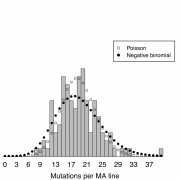In Genetics: over 1,000 spontaneous mutations
Fine-Grained Analysis of Spontaneous Mutation Spectrum and Frequency in Arabidopsis thaliana
Mao-Lun Weng, Claude Becker, Julia Hildebrandt, Matthew T. Rutter, Ruth G. Shaw, Detlef Weigel and Charles B. Fenster
Mutations are the ultimate source of all genetic variation. However, few direct estimates of the contribution of mutation to molecular genetic variation are available. To address this issue, we first analyzed the rate and spectrum of mutations in the Arabidopsis thaliana reference accession after 25 generations of single-seed descent. We then compared the mutation profile in these mutation accumulation (MA) lines against genetic variation observed in the 1001 Genomes Project. The estimated haploid single nucleotide mutation (SNM) rate for A. thaliana is 6.95 × 10?9 (s.e. ±2.68 × 10?10) per site per generation with SNMs having higher frequency in transposable elements (TEs) and centromeric regions. The estimated indel mutation rate is 1.30 × 10?9 (±1.07 × 10?10) per site per generation, with deletions being more frequent and larger than insertions. Among the 1,694 unique SNMs identified in the MA lines, the positions of 389 SNMs (23%) coincide with biallelic SNPs from the 1001 Genomes population, and in 289 (17%) cases the changes are identical. Of the 329 unique indels identified in the MA lines, 96 (29%) overlap with indels from the 1001 Genomes dataset, and 16 indels (5% of the total) are identical. These overlap frequencies are significantly higher than expected, suggesting that de novo mutations are not uniformly distributed and arise at polymorphic sites more frequently than assumed. These results suggest that high mutation rate potentially contributes to high polymorphism and low mutation rate to reduced polymorphism in natural populations providing insights of mutational inputs in generating natural genetic diversity.




